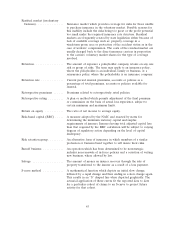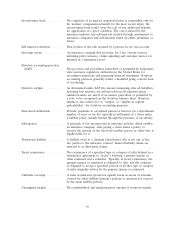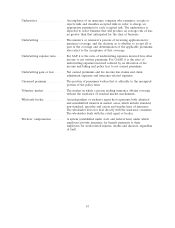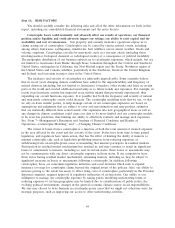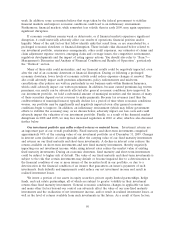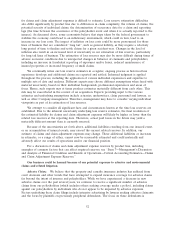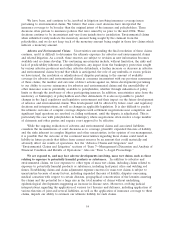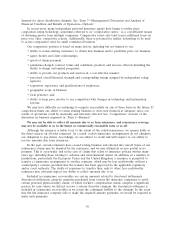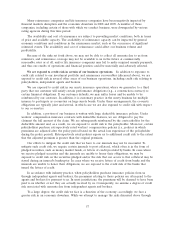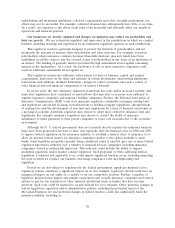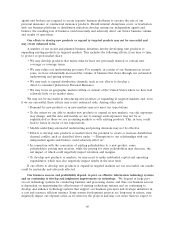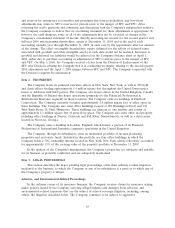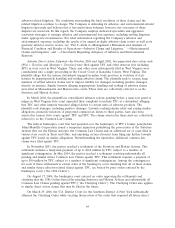Travelers 2009 Annual Report Download - page 67
Download and view the complete annual report
Please find page 67 of the 2009 Travelers annual report below. You can navigate through the pages in the report by either clicking on the pages listed below, or by using the keyword search tool below to find specific information within the annual report.Because of the uncertainties set forth above, additional liabilities may arise for amounts in excess
of the current related reserves. In addition, our estimate of claims and claim adjustment expenses may
change, and such change could be material. These additional liabilities or increases in estimates, or a
range of either, cannot now be reasonably estimated and could materially and adversely affect our
results of operations.
The effects of emerging claim and coverage issues on our business are uncertain. As industry
practices and legal, judicial, social and other environmental conditions change, unexpected and
unintended issues related to claim and coverage may emerge. These issues may adversely affect our
business by either extending coverage beyond our underwriting intent or by increasing the number or
size of claims. Examples of emerging claims and coverage issues include, but are not limited to:
• judicial expansion of policy coverage and the impact of new theories of liability;
• plaintiffs targeting property and casualty insurers, including us, in purported class action
litigation relating to claims-handling and other practices;
• claims relating to construction defects, which often present complex coverage and damage
valuation questions;
• claims under directors’ & officers’ insurance policies relating to: losses from involvement in
financial market activities, such as mortgage or financial product origination, distribution or
structuring; fraud, including those related to investment management businesses; possible
accounting irregularities; and corporate governance issues;
• the assertion of ‘‘public nuisance’’ or similar theories of liability, pursuant to which plaintiffs
seek to recover monies spent to administer public health care programs; abate hazards to public
health and safety and/or recover damages purportedly attributable to a ‘‘public nuisance’’;
• medical developments that link health issues to particular causes, resulting in liability claims; and
• claims relating to potentially changing climate conditions.
In some instances, these emerging issues may not become apparent for some time after we have
issued the affected insurance policies. As a result, the full extent of liability under our insurance
policies may not be known for many years after the policies are issued.
In addition, the potential passage of new legislation designed to expand the right to sue, to remove
limitations on recovery, to extend the statutes of limitations or otherwise to repeal or weaken tort
reforms could have an adverse impact on our business. In particular, recent shifts in the political
landscape could increase the likelihood of the passing of such legislation in a number of states.
The effects of these and other unforeseen emerging claim and coverage issues are extremely hard
to predict and could harm our business and materially and adversely affect our results of operations.
The intense competition that we face could harm our ability to maintain or increase our business
volumes and our profitability. The property and casualty insurance industry is highly competitive, and
we believe that it will remain highly competitive for the foreseeable future. We compete with both
domestic and foreign insurers, a number of which have experienced financial difficulties in recent
periods. Competitors that are experiencing financial difficulties may offer products at prices and on
terms that are not consistent with our economic standards in an effort to maintain or increase their
business. The property and casualty insurance industry has historically been cyclical, with periods
characterized by intense price competition and less restrictive underwriting standards followed by
periods of higher premium rates and more selective underwriting standards. The competitive
environment in which we operate could also be impacted by current general economic conditions,
which could reduce the volume of business available to us, as well as to our competitors. In addition,
the competitive environment could be impacted by changes in customer preferences, including customer
55


